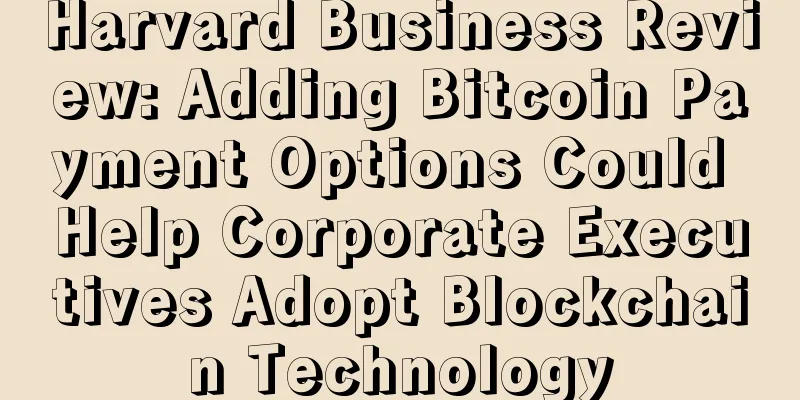Harvard Business Review: Adding Bitcoin Payment Options Could Help Corporate Executives Adopt Blockchain Technology

|
Harvard Business Review (HBR), the flagship magazine of Harvard Business School, published an article on blockchain in its latest issue, expressing skepticism about the hype. They believe that blockchain is a foundational technology rather than a disruptive technology. The adoption of blockchain and its Bitcoin use case is the most significant shift in the economy in decades. This article also provides some advice for business executives on how to apply and adapt to these new economic and social foundations. Blockchain brings a world where contracts can be implemented through digital code, a world where data is shared and stored on a transparent network. Blockchain creates a tamper-proof and non-deletable network. Therefore, by using blockchain, every agreement, process, task and payment in economic activities will be recorded in digital form. This digital signature will be traceable and verifiable, stored and eventually shared in the public domain. The huge potential of blockchain is to make collaboration between individuals, companies, machines and algorithms very smooth because these transactions will rarely involve agents. Such is the efficiency of blockchain technology that it will challenge the professional roles played by bankers, brokers and lawyers, which will be replaced by blockchain technology in the long run. Transformative use cases face many obstaclesHarvard Business Review recognizes that blockchain will transform business and the economy. However, they are concerned about the hype surrounding the technology because there are many technical, governance, organizational and social barriers to overcome. In their blockchain article, they explain that the blockchain-led transformation of business and government will take decades to achieve. This is because blockchain is not a 'disruptive' technology that will threaten existing businesses, but rather a foundational technology.
The HBR article points out similarities between TCP/IP and blockchain. For example, TCP/IP brought an open, shared public network without any central authority to maintain and improve it. The first use case of TCP/IP appeared in 1972. By the late 1980s, more and more companies began to use this protocol to create localized private networks, which then promoted the arrival of the World Wide Web in the mid-1990s, bringing TCP/IP into broad public use. After gaining critical mass users, emerging companies began to use the Internet to create their own business advantages, such as Amazon, CNET, and Expedia. It took TCP/IP more than 30 years to go through the stages of single use, localized use, replacement, and transformation. In contrast, the first single use case of blockchain, Bitcoin, appeared in 2008, so we can infer that blockchain will be widely used by 2038. The following figure shows the comparison between the basic technology TCP/IP and blockchain in the process of economic transformation. Although single-use and localized use cases of blockchain are gaining traction, they are still far from the stage of replacement and transformation use cases. An example of a blockchain replacement use case is cryptocurrency, a new and completely new form of monetary system, such as simple Bitcoin payments. Stellar is one of the most ambitious blockchain application replacement use cases currently. Their goal is to make financial services affordable to people who have never used financial services before, providing them with banking services, micropayments and remittance services. Not only do they offer their own cryptocurrency units, but they also allow the use of other assets on their blockchain, such as other currencies, airtime and data credits. Although Stellar has proven that blockchain is cost-effective and feasible as a banking service standard, there are still high barriers to ecosystem cooperation. It may take years of effort to convince government agencies, central banks and large organizations to adopt blockchain technology. The most transformative blockchain technology currently in use is “smart contracts”, which have the potential to transform economic, social and political systems. However, widespread adoption of smart contracts will still take decades, and by then, smart contracts will have achieved a significant level of organization and transparency in their design, verification, use and regulation. How business executives can prepare for the blockchain revolutionOne way corporate executives are absorbing blockchain technology is by adding Bitcoin as a payment option . This use will force various departments, including IT, finance, accounting, sales and marketing, to create blockchain capabilities. The second, lower-risk strategy is to use “blockchain as an internal database for managing physical and digital assets, recording internal transactions, and verifying identities.” By exploring single use cases, organizations will enter a ‘learning by doing’ process, which will make it easier to adopt cloud blockchain services from large platforms such as Amazon and Microsoft. One way to develop alternative applications is by focusing on alternative solutions that do not require end users to change their behavior and are less expensive. A good example is the blockchain gift card service provided by First Data, which reduces the cost of each transaction while improving security. The HBR article identifies two transformational scenarios that could have a significant impact; the first is large public identity systems , such as passport management systems. The second is algorithm-driven decision-making systems in money laundering prevention and complex multi-party financial transactions. By providing a framework, corporate executives can begin planning how to build their structural capabilities for blockchain today. They need to train their employees, teach them about blockchain, create specific company applications, and invest in blockchain infrastructure. The HBR article concludes that the question is not if blockchain will impact your business, but when:
|
<<: The first blockchain mobile digital bill is put into use
>>: The currency is rising so fast, let's be clear-headed
Recommend
Marriage lines that lead to unhappy marriages
Marriage lines that lead to unhappy marriages Man...
What does it mean to have a mole in your hair?
For a person, there are often corresponding answe...
Is it a good fortune for a man with broken palms on both hands? Palmistry analysis of a man with broken palms on his right hand
A broken palm refers to a palm that is cut across...
What does a mole on a man's chin mean?
A person's mole is very important. Traditiona...
Analysis of the facial features of mistresses
There are two types of mistresses: one who likes t...
What does a man with a mole on his left palm mean?
In life, most people care more about the moles on...
What kind of face attracts wealth?
There are always some people in life who can get ...
Is it good or bad for a woman to have a mole on the tip of her nose? She has good fortune but her ability to keep money is average!
What does a mole on a woman’s nose mean? As we al...
The whole story of the feud between Bitmain and Biyin mining pool
Recently, there were reports that Bitmain sued it...
Does a face with a big nose mean a bad temper?
A person's temper determines their interperso...
What does a man with a low nose mean for his fortune?
What is the fate of a man with a low nose bridge?...
Bitwise Chief Investment Officer: From 312 to 805 BTC, will it repeat the 2020-2021 script?
The cryptocurrency market has sold off sharply th...
Will a man's marriage life be smooth if his marriage line is long?
Most people know that the marriage line can tell ...
What does a sensitive person look like?
In life, each of us has our own personality trait...
Illustration of a large triangle in the center of the palm
There are many different kinds of lines in the pa...









